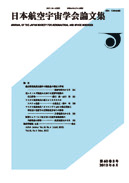All issues

Volume 29, Issue 334
Displaying 1-5 of 5 articles from this issue
- |<
- <
- 1
- >
- >|
-
Kazuhiko KURIBAYASHI, Teruo KISHI, Megumi SUNAKAWA1981 Volume 29 Issue 334 Pages 557-566
Published: November 05, 1981
Released on J-STAGE: May 25, 2009
JOURNAL FREE ACCESSDownload PDF (625K) -
Kohseh KUWABARA, Shigeo UCHIDA1981 Volume 29 Issue 334 Pages 567-573
Published: November 05, 1981
Released on J-STAGE: May 25, 2009
JOURNAL FREE ACCESSIn the preceeding paper by the present authors, an incompressible turbulent plane jet curved under the influence of constant pressure differences across it is treated by the use of a small perturbation method with a small parameter expressed as a power function of the streamwise coordinate. Referring to the calculateds results it is inferred that the constant eddy viscosity assumption included in the SAWYER's expression for the shear stress, gives a pseudo-curvature effect in the second order solution, resulting in less symmetrical velocity distributions unlike the experimental observations.
The present paper considers the same problem using almost the same method as in the previous one, with an eddy viscosity expression simulating the lateral turbulence intensity measured about the linear jet, giving rather symmetrical velocity profiles in the whole flow field of the curved jet. And an empirical constant in the SAWYER's expression is estimated to be about 5 by the comparison of the calculated angle between the streamlines and the locus of the maximum velocity point with the measured value.
Besides it is shown that the two zero positions of the shear stress and the velocity gradient do not fall on one point in this flow, the former shifts to the low pressure side and the latter to the otherside, and it is also shown approximately that the minimum static pressure in each cross section appears within the jet region and its value rises gradually downstream.View full abstractDownload PDF (434K) -
Eiichi NAKAI1981 Volume 29 Issue 334 Pages 574-588
Published: November 05, 1981
Released on J-STAGE: May 25, 2009
JOURNAL FREE ACCESSSome experimental investigations on the transonic flutter characteristics have been conducted by the use of thin plate cantilevered wing models with sweptback tapered tips, which were elastically supported at the root, in the NAL 0.6m×0.6m transonic blowdown wind tunnel for flutter testing in the range of Mach numbers from 0.804 to 1.171.
The wing models have the tip planform of sweptback angles of 35° at the leading edge and 30°at 1/4 chord line, and aspect ratio of 1.017 and taper ratio of 0.6.
It is concluded that the flutter boundaries of the wing models have been obtained and the boundaries expressed by the "experimental flutter speed coefficient" are characterised by having the minimum values at around Mach number of 1.0, and that the considerable increase of flutter instability area is caused by the decrease in the stiffness of elastic support at the root of the model.View full abstractDownload PDF (1242K) -
Shiki OKAMOTO, Tetsushi OKAMOTO1981 Volume 29 Issue 334 Pages 588-594
Published: November 05, 1981
Released on J-STAGE: May 25, 2009
JOURNAL FREE ACCESSA theoretical study of the blockage effect of a wind tunnel wall on the wake behind a twodimensional flat plate standing normal to the opposite wall is presented. The flow studied was an incompressible potential flow past a flat plate having a closed wake region in which a stationary vortex exists. The streamlines and the surface distributions were obtained. From those results it was found that the drag of the plate increases and the closed wake region is reduced with increasing the ratio of the height (H) of the plate to the tunnel height (h), and that the blockage effect can be ignored for H/h<0.05.View full abstractDownload PDF (2644K) -
Finite Element AnalysisTakashi YOKOYAMA, Masayuki TSUZUKI1981 Volume 29 Issue 334 Pages 594-604
Published: November 05, 1981
Released on J-STAGE: May 25, 2009
JOURNAL FREE ACCESSThe influence of rotatory inertia and shear deformation on the transient response of elastic beams is examined to make an assesment of the importance of these two effects. A finite element method is presented for analyzing the transient response of semi-infinite elastic beams impacted at the one ends by half-sine moment pulses. The direct integration of the equations of motion is performed by the NEWMARK beta method. The selection of an appropriate time step for direct integration is made based on the condition number determined from the relevant matrices.
Numerical examples are presented and are compared with both experimental data and characteristics solutions in the literature. It is found from the present study that, except when the pulses are exceedingly short, computed results based on the TIMOSHENKO beam theory give the best agreement with experimental results, and that shear deformation has a greater influence on the transient response of elastic beams than rotatory inertia.View full abstractDownload PDF (550K)
- |<
- <
- 1
- >
- >|